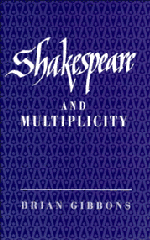Book contents
- Frontmatter
- Contents
- Acknowledgements
- 1 Introduction
- 2 Fabled Cymbeline
- 3 A speechless dialect: interpreting the human body in Shakespeare's plays
- 4 Shakespeare's ‘road of excess’: Titus Andronicus, The Taming of the Shrew, King Lear
- 5 Always topical: Measure for Measure
- 6 Amorous fictions in As You Like It
- 7 Unstable Proteus: Marlowe and Antony and Cleopatra
- 8 Multiplicity
- Notes
- Bibliography
- Index
- Frontmatter
- Contents
- Acknowledgements
- 1 Introduction
- 2 Fabled Cymbeline
- 3 A speechless dialect: interpreting the human body in Shakespeare's plays
- 4 Shakespeare's ‘road of excess’: Titus Andronicus, The Taming of the Shrew, King Lear
- 5 Always topical: Measure for Measure
- 6 Amorous fictions in As You Like It
- 7 Unstable Proteus: Marlowe and Antony and Cleopatra
- 8 Multiplicity
- Notes
- Bibliography
- Index
Summary
Shakespeare in his last phase from Antony and Cleopatra to The Tempest shows dazzling stylistic virtuosity, and an uninhibited readiness to manipulate his audiences through surprise, thrill and shock; yet a readiness to do the unexpected, boldly breaking with established dramatic conventions, is not something he only developed late in his career – on the contrary, it is a consistent feature of his work, apparent from his earliest comedies, not only in the extraordinary Act 5 of Love's Labour's Lost, culminating in the entry of Marcade, but even in the ostensibly classical confines of The Comedy of Errors, and in its opening moments, which present the most solemn and gloomy occasion, as old Aegeon is condemned to death and faces his last few hours on earth.
By beginning with the romance plot Shakespeare teases an audience that he is going to break the non-classical rules of the three unities, which the educated element in the public would have been taught to respect. The classic Elizabethan statement of these rules is Sir Philip Sidney's in his essay An Apology for Poetry (1581 – though only actually published in 1595). Sidney ridicules early Elizabethan drama's readiness to represent directly on stage ‘story which containeth many places and many times’; he impatiently points out that such material should be relegated to a reporter's account. He sketches a lively caricature of a typical Elizabethan ‘mongrel’ dramatic plot: ‘two young Princes fall in love. After many traverses, she is got with child, delivered of a fair boy; he is lost, groweth a man, falls in love, and is ready to get another child, and all this in two hours space’.
- Type
- Chapter
- Information
- Shakespeare and Multiplicity , pp. 203 - 211Publisher: Cambridge University PressPrint publication year: 1993



